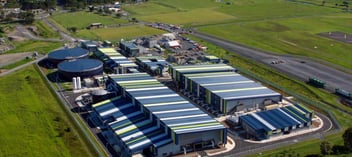Harnessing growth and innovation to drive sustainable water solutions

With climate pressures mounting and water security under strain, Australia’s water sector is accelerating efforts to deliver smart, sustainable solutions.
The experience of one leading water technology company shows that extending asset life, shifting to climate-independent sources, and tailoring solutions to specific challenges are critical to achieving long-term resilience.
Principal sponsor of Ozwater’25, Osmoflo has experienced substantial growth in recent years, and CEO and Managing Director Carmine Ciccocioppo said the Ozwater’25 theme – looking back, moving forward – is particularly pertinent for the 35-year-old company.
"A big driver behind Osmoflo’s growth is the increasing impacts of climate change across both public and private sectors. We’re seeing a marked shift towards non-climate-dependent sources of water, including desalination and advanced reuse,” he said.
“This trend plays to Osmoflo’s strengths. Our core competencies are around membrane technology and desalination, that is where the roots of the company lie. These are really at the heart of most non-climate-dependent water sources.”
Ciccocioppo said there’s no doubt Australia is facing growing challenges, as the impacts of climate change compound the geographic reality of living on the driest inhabited continent on Earth, which is why connection and collaboration is so important.
“We believe that the Australian water sector is uniquely positioned to respond to the significant scale, resource and schedule challenges, if we work together,” he said.
“Ozwater presents a unique opportunity for companies like Osmoflo to make new connections and forge new relationships, as well as strengthen existing bonds with all parts of the water community.
“It also creates an environment where the industry as a whole – including designers, suppliers, contractors and owner-operators of new water treatment assets, technologies and processes – can share ideas and real-world lessons from a practitioner’s perspective. This is critical when driving for optimal outcomes and efficiency.
“It is this sharing of knowledge that will allow true collaboration, and further innovation to meet the needs of society and our clients.”
Tackling sustainability
With water security front and centre of Osmoflo’s work, Ciccocioppo said there are noticeable trends emerging around how best to approach and achieve sustainable water management.
“There’s a growing expectation around increased transparency in corporate reporting with respect to the sustainability of the primary water sources utilised by an organisation and how sustainably that water is managed. Large corporates, including in the mining, oil and gas, power generation, microelectronic and food and beverage sectors, are moving towards ‘net zero’ or even ‘water positive’ outcomes,” he said.
“It's not just about achieving ‘net zero’ water, but often about actually contributing water back to the community, including First Nations communities. That includes moving reliance away from high-value sources like potable mains water or limited, high quality groundwater resources, and looking at maximising reuse and minimising discharge.
A key component of sustainable water management and promoting circularity in the water sector is extending the useful economic life of existing assets for as long as possible, Ciccocioppo said, an issue Osmoflo is meeting head on with specalised services.
“We set up our new business division, OASIS [Osmoflo’s Asset Sustainment and Improvement Service] a couple of years ago now,” he said.
“OASIS has already assisted a multitude of clients to upgrade, modify or rehabilitate their aging water and wastewater treatment assets in order to either extend operating life, improve asset performance or combinations of both.
“We’ve owned and operated our own water treatment assets for nearly 25 years. This long-standing experience has built up our awareness and capability in sustaining and extending asset life. With the recent focus on circularity, one of the best ways to reduce impact is by extending the life of existing assets and deferring the need for new ‘greenfield’ assets which invariably come with a much higher carbon footprint and significantly more waste.
"OASIS was formed to deliver that service not just to those customers who bought Osmoflo plants, but essentially to any owner of water or wastewater treatment assets, regardless of the history or the age of the asset.”
Unique problems, unique solutions
One of the key lessons Osmoflo has learned over the years is that the needs and drivers of different market sectors are highly diverse, and continue to diverge.
“Those needs can definitely not be addressed with a ‘one-size-fits-all’ solution or even with a range of standardised products. They are all uniquely different and ultimately can only be efficiently addressed with a carefully tailored and customised solution,” Ciccocioppo said.
“The two common elements in virtually every case in developing effective solutions and outcomes, are to achieve an accurate definition of the problem by asking the right questions and seeking the right level of detail, as well as building close collaboration with the client and all relevant stakeholders during the solution development phase.”
Ciccocioppo said the key to delivering the best possible value for money for clients lies in the ability to innovate, and utilise the best available technology and products from across the entire water sector.
“Keeping abreast of the vast number of new product developments and technologies entering the market each year and understanding how to optimally utilise and integrate those into ‘best-of-class’ solutions is a core competency that will shape our future focus and strategies,” he said.
Future thinking
As circular economy initiatives continue to unfold across the sector, Ciccocioppo said a key area of development is within membrane design and reuse.
“No one has yet cracked one of the largest barriers to circularity in the membrane treatment sector around how to reconstitute or reuse RO and UF membranes, which comprise relatively intractable and non-recyclable hydrocarbon-based constituents such as Thin Film Composite, PVDF. Traditionally, RO membranes are replaced every 3–5 years, depending on the application and the design parameters. If we could double that duration, then in theory you would halve the landfill burden,” he said.
“So, the current approach is to extend membrane lifespan as much as possible.
“One new technology we’ve aligned with is Aqua Membranes – an RO membrane that uses a novel 3-D printed spacer instead of a traditional mesh spacer.
"This provides more membrane surface area and more efficient flow paths through a standard 8-inch spiral wound module, which in turn improves energy efficiency, reduces chemical cleaning and lowers biofouling and scaling risks.
“All the early signs are that, apart from being more efficient and providing more product water capacity, they are likely to also last significantly longer than traditional membranes due to the need for less frequent cleaning, less propensity for fouling and scaling, and lower system operating pressures.
“If you’ve got an existing desal plant and want lower energy use or more capacity, replacing the existing RO elements with these membranes can offer immediate and significant benefits without a full plant overhaul or capacity expansion.”
Another key trend that Osmoflo is leaning into is around the development and implementation of recyclable ceramic membranes, Ciccocioppo said.
“Ceramics are robust, easier to clean, less prone to fouling and theoretically fully recyclable at end-of-life. Unlike polymeric membranes, which always end up in landfill, ceramics support the objective of circularity,” he said.
“They also use less energy and can be retrofitted into existing ‘conventional’ plants like activated sludge systems or conventional filtration facilities, which can significantly increase plant capacity and performance.”
Interested in learning more about how water organisations are leading the way towards sustainable water management? Register for Ozwater’25 and join us at Australia’s premier water conference and exhibition.

